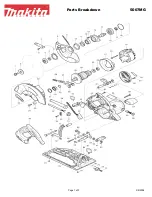
32
Transporting and Mounting
Mounting Applications
Be certain the miter
saw
is
mounted
or
placed on a level, firm work surface before
using.
A level and firm work surface re-
duces the risk of the miter saw becoming
unstable.
WORKBENCH PERMANENT
ATTACHMENT
1.
Each of the four mounting holes should
be bolted securely using 5/16" (M8)
bolts, lock washers and hex nuts (not in-
cluded), see Fig. 26.
2.
Locate and mark where the saw is to be
mounted.
3.
Drill four 5/16" (8mm) diameter holes
through work-bench.
4.
Place the miter saw on the workbench,
aligning holes in base with holes drilled
in workbench. Install bolts, lock washers
and hex nuts.
ALTERNATE ATTACHMENT
The smaller mounting holes at each corner
can be used for nails or longer drywall
screws.
The supporting surface where the saw is to
be mounted should be examined carefully
after mounting to ensure that no movement
can occur during use. If any tipping or walk-
ing is noted, secure the workbench or stand
before operating the miter saw.
Be careful not to over-
drive
nail
or
over-
torque the bolt. This could crack foot or
damage base.
TEMPORARY MOUNTING USING
CLAMPS
•
If necessary, clamp the miter saw to a
workbench or table top.
•
Place two or more “C” clamps on the
clamping areas and secure (see Fig. 27).
There are clamping areas at all four cor-
ners of the saw.
•
Be careful not to place clamps over the
base extension clamping levers (see Fig.
27).
•
Mounting with clamps may prevent ac-
cess to some wide miter angles.
Bolt Hole
Nail Hole
Rear
Mounting
Holes
Clamp
Area
Clamp
Area
Fig. 26
Fig. 27
1609B06757.qxp_GCM18V-12GDC 3/25/20 12:35 PM Page 32
















































